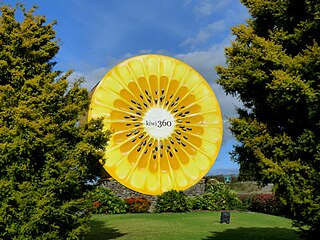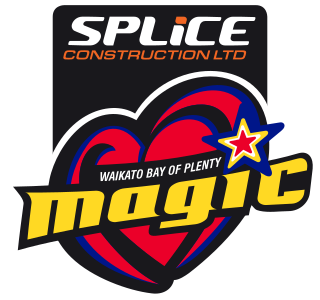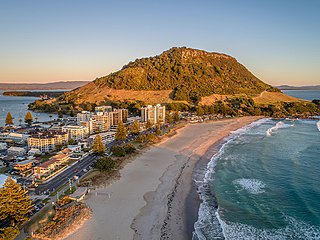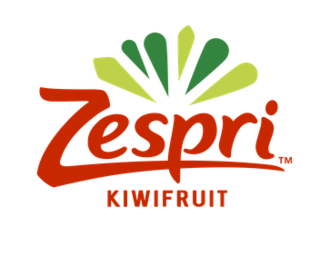Related Research Articles

Kiwifruit or Chinese gooseberry, is the edible berry of several species of woody vines in the genus Actinidia. The most common cultivar group of kiwifruit is oval, about the size of a large hen's egg: 5–8 centimetres in length and 4.5–5.5 cm in diameter. Kiwifruit has a thin, fuzzy, fibrous, tart but edible light brown skin and light green or golden flesh with rows of tiny, black, edible seeds. The fruit has a soft texture with a sweet and unique flavour.

Hamilton is an inland city in the North Island of New Zealand. Located on the banks of the Waikato River, it is the seat and most populous city of the Waikato region. With a territorial population of 185,300, it is the country's fourth most-populous city. Encompassing a land area of about 110 km2 (42 sq mi), Hamilton is part of the wider Hamilton Urban Area, which also encompasses the nearby towns of Ngāruawāhia, Te Awamutu and Cambridge. In 2020, Hamilton was awarded the title of most beautiful large city in New Zealand. Hamilton is now considered the fastest growing city in the country.

The University of Waikato, established in 1964, is a public research university located in Hamilton, New Zealand. An additional campus is located in Tauranga. The university performs research in numerous disciplines such as education, social sciences, and management and is an innovator in environmental science, marine and freshwater ecology, engineering and computer science. It offers degrees in health, engineering, computer science, management, Māori and Indigenous Studies, the arts, psychology, social sciences and education.
Ruakura is a semi-rural suburb of Hamilton City, in the Waikato region of New Zealand. The University of Waikato is nearby.

Te Puke is a town located 18 kilometres southeast of Tauranga in the Western Bay of Plenty of New Zealand. It is particularly well known for the cultivation of Kiwifruit.
AsureQuality Limited is a State-Owned Enterprise (SOE) fully owned by the government of New Zealand. The company's core business is food quality assurance with its services including certification, inspection, testing, and training. AsureQuality has over 1700 staff at over 100 locations throughout New Zealand. AsureQuality also has a joint venture partner, Bureau Veritas.. Bureau Veritas and AsureQuality have two joint ventures, BVAQ Australia and BVAQ SouthEast Asia.

Hamilton East is a suburb in central Hamilton in New Zealand. The suburb's primary commercial and retail precinct is located along Grey Street. Hamilton East is characterised by villas and bungalows built early in the 20th century.

The East Coast Main Trunk (ECMT) is a railway line in the North Island of New Zealand, originally running between Hamilton and Taneatua via Tauranga, connecting the Waikato with the Bay of Plenty. The ECMT now runs between Hamilton and Kawerau, with a branch line to Taneatua from the junction at Hawkens. The line is built to narrow gauge of 1,067 mm, the uniform gauge in New Zealand. It was known as the East Coast Main Trunk Railway until 2011, when the word "Railway" was dropped.

Waikato Bay of Plenty Magic are a New Zealand netball team based in Hamilton. The team were formed in 1998, following the merger of Waikato Wildcats and Bay of Plenty Magic. In 1997, Wildcats and Magic had been founder members of the Coca-Cola Cup/National Bank Cup league. Between 1999 and 2007, the new team continued to play in the league. Magic are the only team from the Coca-Cola Cup/National Bank Cup era to have retained their original name. Between 2008 and 2016, they played in the ANZ Championship. Since 2017, Magic have represented Netball Waikato Bay of Plenty in the ANZ Premiership. Netball Waikato Bay of Plenty is the governing body that represents the North Island regions of Waikato and Bay of Plenty. During the National Bank Cup era, Magic were premiers in 2005 and 2006. During the ANZ Championship era, Magic were the most successful New Zealand team. In 2008 they were minor premiers and they were grand finalists in 2008 and 2010 before winning the overall title in 2012. They were the only New Zealand team to win the ANZ Championship.
The Waikato Expressway is a dual carriageway section of State Highway 1 in New Zealand's Waikato region. Constructed in stages, it forms part of the link between Auckland and Hamilton. Currently stretching from Auckland to south of Cambridge, the first section of the highway was built in 1993. Throughout its lifetime, it has undergone many upgrades to optimise traffic flow throughout the Waikato region, including various bypasses of many towns in the region, culminating with Hamilton in 2022.

Kiwifruit or kiwi is a major horticultural export earner for New Zealand. New Zealand developed the first commercially viable kiwifruit and developed export markets, creating the demand for the fruit that exists today. Today New Zealand is the third largest kiwifruit producing country, next to China and Italy, and holds approximately 30% of the market share. In the 2008–2009 season the value of New Zealand kiwifruit exports was NZ$1.45 billion.

Mānuka honey is a monofloral honey produced from the nectar of the mānuka tree, Leptospermum scoparium.

Tauranga is a coastal city in the Bay of Plenty Region and the fifth-most populous city of New Zealand, with an urban population of 161,800, or roughly 3% of the national population. It was settled by Māori late in the 13th century, colonised by Europeans in the early 19th century, and was constituted as a city in 1963.

Go Bus Transport Ltd is a large bus company operating in New Zealand owned by Australian-based transport operator Kinetic Group. The company is based in Hamilton, New Zealand, and runs bus services in Hamilton, Hawke's Bay, Tauranga, Christchurch, Gisborne, Dunedin and Invercargill.
Peter Charles Molan was a New Zealand biochemist, noted for his elucidation of the medicinal properties of mānuka honey.

Zespri International Limited is the world's largest marketer of kiwifruit, selling in over 50 countries. Its international headquarters are in Mount Maunganui, New Zealand. However, it has licensed growers in Italy, France, Japan, South Korea, Greece and Australia, with trials in place in several other countries. Kiwifruit from New Zealand is available from May to October. To satisfy year-round consumer demand, Zespri markets kiwifruit from Italy from November to January.

Te Huia is a passenger train service between Hamilton, Papakura, and Auckland in New Zealand. The service is a five-year trial with subsidies from the NZ Transport Agency and Waikato local authorities. The opening was delayed because of COVID-19 and the need to replace some rail track. A new starting date was announced, and the service began on 6 April 2021. Subject to consultation, the 2024 GPS, which sets out government spending plans for transport, does not include the $50m a year to 2026, for inter regional public transport, which was in the draft GPS of August 2023, issued by the previous Labour government, and which was being used to fund Te Huia.
Newstead is a rural settlement on the outskirts of Hamilton, in the Waikato District and Waikato region of New Zealand's North Island.

This article documents the chronology of the response to the COVID-19 pandemic in September 2021, which originated in Wuhan, China in December 2019. Some developments may become known or fully understood only in retrospect. Reporting on this pandemic began in December 2019.
Merilyn Manley-Harris is a New Zealand chemist, and is a professor emeritus at the University of Waikato, specialising in carbohydrate chemistry, particularly relating to mānuka honey.
References
- 1 2 3 4 5 "About Us". Hill Labs. 2024. Retrieved 13 March 2024.
- 1 2 3 4 "Hamilton's Hill Laboratories moves into high-quality food safety auditing for export". NZ Herald (Waikato Herald). 21 February 2023. Retrieved 8 March 2024.
- 1 2 3 4 5 6 "Hill Laboratories signs contract with Zespri to make sure kiwifruit stays tasty". New Zealand Herald (Bay of Plenty Times). 16 October 2020. Retrieved 8 March 2024.
- 1 2 3 4 Berry, Michael (21 February 2012). "Wine-testing lab first of its kind in NZ". stuff.co.nz. Retrieved 8 March 2024.
- 1 2 3 Deavoll, Pat (17 May 2017). "New tests confirm New Zealand manuka honey is for real". stuff.co.nz. Retrieved 19 March 2024.
- 1 2 3 4 Baker, Glenn (15 March 2018). "New Hill Labs CEO continues family association". NZ Business. Retrieved 8 March 2024.
- 1 2 Lines-MacKenzie, Jo (24 May 2020). "Coronavirus: Hamilton's private lab helping test for Covid-19". stuff.co.nz. Retrieved 8 March 2024.
- ↑ Mohobane, Thabiso (2008). The characteristics and impacts of landfill leachate from Horotiu, New Zealand and Maseru, Lesotho: A comparative study (MSc thesis). The University of Waikato.
- ↑ Dean, Hamish Alston (2013). Restoration of three indigenous forest types in Tauranga City, New Zealand (MSc thesis). The University of Waikato. hdl:10289/7898.
- ↑ Chiswell, Stephen M.; Nodder, Scott D. (2015). "Tilt-induced biases in sediment trap functioning". Journal of Geophysical Research: Oceans. 120 (12): 8381–8391. Bibcode:2015JGRC..120.8381C. doi:10.1002/2015JC011350.
- ↑ Maheswaran, Sarmini (2023). Nutrient leaching under intensive sheep grazing (PhD thesis). Massey University. hdl:10179/18210.
- ↑ White, P.S.; Graham, F.F.; Harte, D.J.G.; Baker, M.G.; Ambrose, C.D.; Humphrey, A.R.G. (2012). "Epidemiological investigation of a Legionnaires' disease outbreak in Christchurch, New Zealand: the value of spatial methods for practical public health". Epidemiology and Infection. 141 (4): 789–799. doi:10.1017/S0950268812000994. PMID 22697112.
- ↑ Buckle, K.N.; Young, M.J.; Alley, M.R. (2014). "Investigation of an outbreak of craniofacial deformity in yellow-eyed penguin (Megadyptes antipodes) chicks". New Zealand Veterinary Journal. 62 (5): 250–257. doi:10.1080/00480169.2014.906332. PMID 24841759.
- ↑ "This non-alcoholic kombucha has nearly 3 times the legal alcohol limit". 1 News. 16 November 2022. Retrieved 8 March 2024.
- ↑ Neilsen, J.A.; Frew, R.D.; Whigham, P.A.; Callaway, R.M.; Dickinson, K.J.M. (2014). "Thyme invasion and soil properties in the Central Otago region of New Zealand". Geoderma Regional. 1: 48–58. Bibcode:2014GeodR...1...48N. doi:10.1016/j.geodrs.2014.08.002.
- ↑ "National standards for discrete water quality sampling released". NIWA. 2019. Retrieved 13 March 2024.
- ↑ "Mānuka honey". Ministry of Primary Industry. 5 February 2018. Archived from the original on 25 January 2020. Retrieved 19 March 2024.
- ↑ "Construction Updates". Hills Village. Retrieved 2021-10-16.
- ↑ Franke-Bowell, Jonah (22 October 2022). "From labs to luxury - swanky Hamilton apartments ready for residents". stuff.co.nz (Waikato Times). Retrieved 8 March 2024.